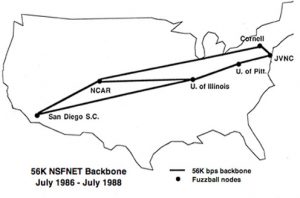NSFNET with 56 kbit/s links


Date: 01/01/1986
The NSFNET greatly increased the speed and capacity of the Internet (increasing the bandwidth on backbone links from 56 Kbits/second to 1.5 Mbits/second and then to 45 Mbits/second), and greatly increased the reliability and reach of the Internet reaching more than 50 million users in 93 countries when control of the Internet backbone was transferred from the U.S. Government to the telecom carriers and commercial Internet Service Providers in April 1995.
NSFNET is also the name given to a nationwide physical network that was constructed to support the collective network-promotion effort. That network was initiated as a 56 kbps backbone in 1985. The network was significantly expanded from 1987 to 1995, when the early version of NSFNET was upgraded to T1 and then T3 speeds and expanded to reach thousands of institutions. Throughout this period, many projects were associated with the NSFNET program, even as the backbone itself became widely known as “the NSFNET.”
The initial NSFNET consisted of a network backbone built with 56 kbps lines by a team from the University of Illinois National Center for Supercomputing Applications (NCSA) and the Cornell University Theory Center, because they were the biggest TCP/IP proponents, with help from Dave Mills of the University of Delaware and Hans-Werner Braun of Merit Networks Inc. While 56 kbps sounds awfully slow compared to today’s Internet, the load on the early NSFNET was correspondingly less as well — there was no multimedia yet, and simple wireframe and contour graphics were as complex as most communications got.
56 kb/s backbone
The NSFNET initiated operations in 1986 using TCP/IP. Its six backbone sites were interconnected with leased 56-kb/s links, built by a group including the University of Illinois National Center for Supercomputing Applications (NCSA), Cornell University Theory Center, University of Delaware, and Merit Network. PDP-11/73 minicomputers with routing and management software, called Fuzzballs, served as the network routers since they already implemented the TCP/IP standard. This original 56 kbit/s backbone was overseen by the supercomputer centers themselves with the lead taken by Ed Krol at the University of Illinois at Urbana-Champaign. PDP-11/73 Fuzzball routers were configured and run by Hans-Werner Braun at the Merit Network and statistics were collected by Cornell University.
Support for NSFNET end-users was provided by the NSF Network Service Center (NNSC), located at BBN Technologies and included publishing the softbound “Internet Manager’s Phonebook” which listed the contact information for every issued domain name and IP address in 1990. Incidentally, Ed Krol also authored the Hitchhiker’s Guide to the Internet to help users of the NSFNET understand its capabilities. The Hitchhiker’s Guide became one of the first help manuals for the Internet. As regional networks grew the 56 kbit/s NSFNET backbone experienced rapid increases in network traffic and became seriously congested. In June 1987 NSF issued a new solicitation to upgrade and expand NSFNET.